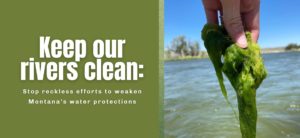By Derf Johnson

Clean rivers aren’t always at the top of our minds in the middle of winter, but due to some very consequential policy discussions and a current rulemaking process by the Montana Department of Environmental Quality (DEQ), it has become one of MEIC’s top priorities. DEQ and a number of stakeholders are steeped in a working group and series of three rulemakings that will implement SB 358, the Montana Legislature’s directive to DEQ to revise the nutrient pollution regulations for Montana’s waterways. (For more information on nutrient pollution and the regulatory “rollback,” see the story in the Dec. 2021 issue of Down to Earth.) These rulemakings may prove critical in determining the future of Montana’s clean water and the ecological integrity of our streams and rivers.
SB 358 required DEQ to have adopted regulations implementing the bill by March 1 of this year. That has proven very challenging. The biggest problem with implementing – really, rolling back – the rules has been that non-point sources are not adequately brought into the regulatory scheme. A major impetus for the passage of SB 358 was that the regulatory burden was increasingly falling on point source polluters, such as industrial plants and municipal facilities, while non-point sources continued to cause a large share of the pollution. However, it currently appears that the new narrative standards will provide a free pass to both point and non-point source polluters, which is a rollback from the status quo and will leave Montana’s rivers and streams in bad shape.
All is not lost. First, there are serious questions about whether SB 358 and its rulemaking processes comply with the federal Clean Water Act. Any rule that is ultimately adopted by DEQ must be approved by the U.S. Environmental Protection Agency, which has been keenly monitoring the proceedings. In addition, Upper Missouri Waterkeeper (UMW) has filed a 60-day notice at the EPA, requesting that the agency reject Montana’s pollution rollback.
Second, the first round of proposed rules was characterized by DEQ as a “framework,” largely to comply with the March 1 deadline. There will be at least two additional rulemakings, during which MEIC and the public will have the opportunity to provide additional comments and speak up for clean water. We will be sure to tell you about the deadlines and public hearing dates, as well as provide talking points on the proposed rules.
MEIC has been proud to work with a broad coalition of like-minded organizations on this issue, including UMW, Northern Plains Resource Council, Clark Fork Coalition, Montana Trout Unlimited, and others. These partners have been invaluable in generating technical and public comments, submitting opinions to news outlets, and holding DEQ accountable.
This article was published in the March 2022 issue of Down To Earth.

